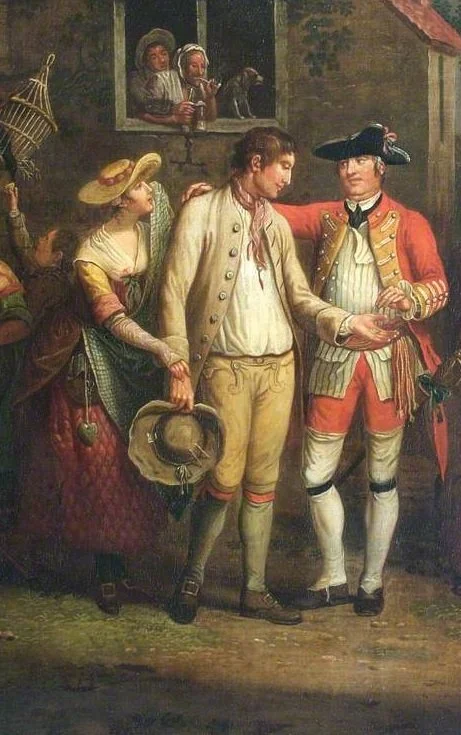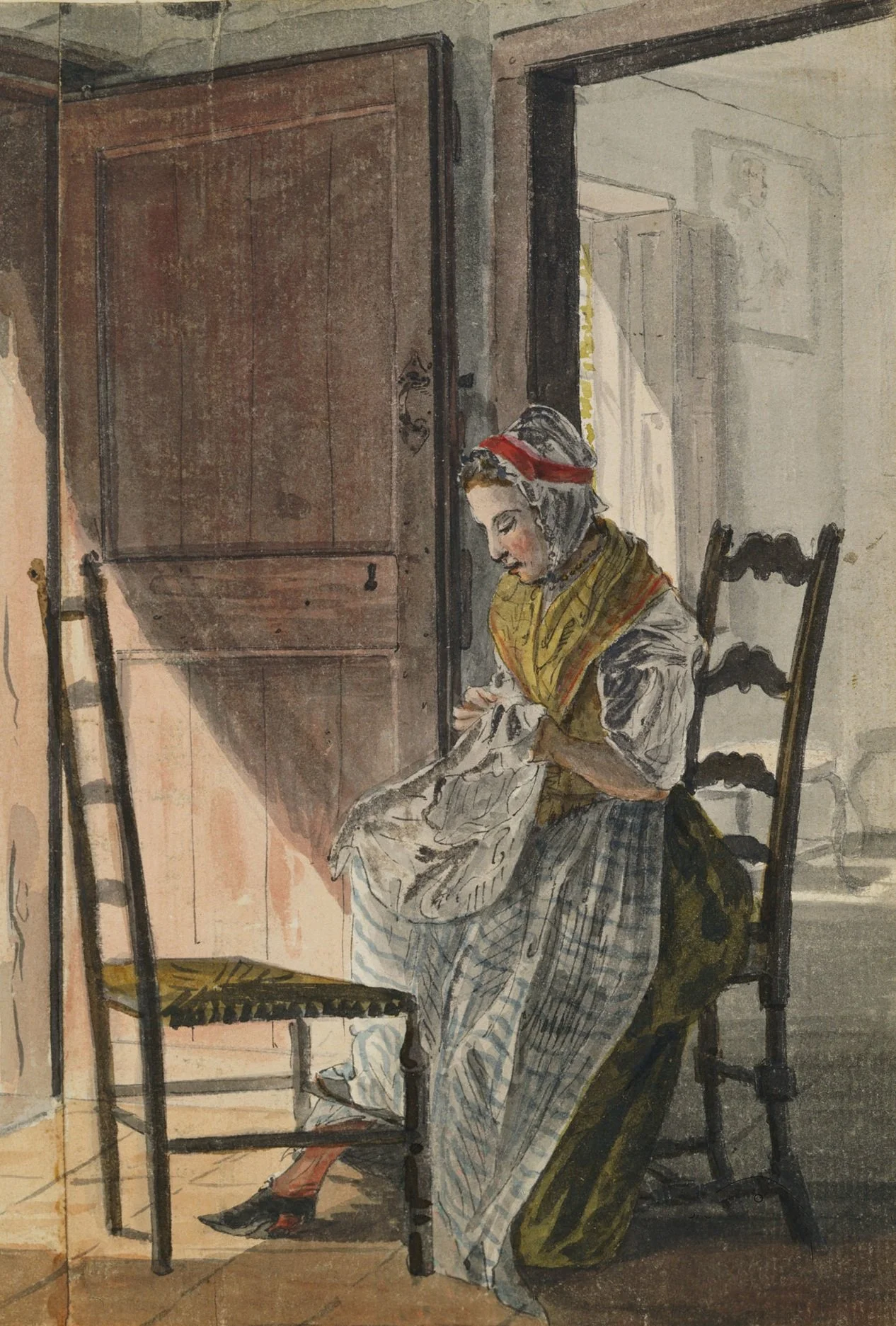Checked aprons for 18th century women
The predominant color combination seen on 18th century check aprons is a dark blue check on a white ground.
The Annals of Philadelphia notes, “Very decent women went abroad and to churches with check aprons. I have seen those, who kept their coach in my time to bear them to church, who told me they went on foot with a check apron to the Arch Street Presbyterian meeting in their youth.”
Camilla, a novel published in 1796, reveals some contemporary attitudes about the English women who wore checked aprons:
Mr. Dennel and Mrs. Arlbery, who neither of them, at any time, took the ſmalleſt notice of what ſhe ſaid, paſſed on, and left the whole weight of both her perſon and her complaints to Camilla. The latter, however, now reached the ears of a fat, tidy, neat looking elderly woman, who, in a large black bonnet, and a blue checked apron, was going their way; ſhe approached them … The woman ſaid, “Why what’s here to do? Why ſee, my dear, if I muſt let you into the ſecret,—you muſt know—but don’t tell it to the world!—I’m a gentlewoman!” She then removed her checked apron, and ſhewed a white muſlin one, embroidered and flounced.
Miſs Dennel was now ſtruck with a ſurpriſe, of which Camilla bore an equal ſhare. Their new acquaintance appeared herſelf in ſome confuſion, but having exacted a promise not to be diſcovered to the world, ſhe told them, ſhe lodged at a houſe upon Mount Pleaſant, juſt by their’s, whence ſhe often ſaw them; that, having a ticket given her, by a friend, for the play, ſhe dreſſed herſelf and went into a box, with ſome very genteel company, who kept their coach, and who ſat her down afterwards at another friend’s, where ſhe pretended ſhe ſhould be fetched: “But I do my own way,” continued ſhe, “and nobody knows a word of the matter: for I keep a large bonnet, and cloak, and a checked apron, and a pair of clogs, or pattens, always at this friend’s; and then when I have put them on, people take me for a mere common perſon, and I walk on, ever ſo late, and nobody ſpeaks to me; and ſo by that means I get my pleaſure, and ſave my money; and yet always appear like a gentlewoman when I’m known.”
Check aprons are frequently described in runaway advertisements. Additional references to check aprons from English sources in 1772, 1778, 1780, 1787, 1788, 1789, 1790, 1792, 1797, 1797, and 1799. Also, check aprons are sometimes mentioned in the Proceedings of the Old Bailey, such as the 1751 trials of Lucy Beard and Sarah Castele.
Extant check aprons
ModeMuseum OBJ35268, a pink and blue checked apron, 1750-1800
Colonial Williamsburg 1999-225, blue and white woven check linen apron, America, 1776
A woman’s apron of blue and white checked linen, c. 1770-1850, in Fitting & Proper
PVMA 2000.01.869, c. 1790-1840
OSV 26.39.11, a blue and white check linen apron, c. 1800-1820 (a later style that tied just below the bust)
PVMA 1882.035.01, a blue-checked apron made by Judith Allen Bardwell of Deerfield Massachusetts, c. 1800-1840, made of “ blue and white checked linen … [that] was a common feature of everyday life in the 18th century Connecticut Valley.”
Schwenkfelder 1916.01.05, “a woman’s handstitched apron comprised of a handspun blue and bleached white woven checked linen” worn by Susanna S. (Kriebel) Anders of Montgomery County, Pennsylvania c. 1820-1826
Checked aprons in artwork & illustrations
A girl knitting, attributed to André Bouys
A woman pushing a wheelbarrow full of fruit by Francis Grose, c. 1746-1791
At Sandpit Gate by Paul Sandby, c. 1752
A market woman in Edinburgh by Paul Sandby
Annette de Fourqueux by Louis Carrogis Carmontelle
A kitchen scene by Paul Sandby, c. 1754
The Way to Preferment, 1758
Dr Oliver and Mr Peirce, the First Physician and Surgeon Examining Patients Afflicted with Paralysis, Rheumatism and Leprosy by William Hoare, 1761
Marie-Denise, de Marly la ville by Louis Carrogis Carmontelle, 1763
The Recruiting Sergeant by John Collet, 1767
Kitchen interior with a young woman cleaning fish and a boy with a hobby horse by Abraham Hendrik van Beesten, 1769
The weaver’s wife in Saint Monday in the Afternoon, or All Nine and Swallow the Bowl, 1770s
A Cambridge Woman Servant by Edward Topham, 1771
Inside of a weaver’s cottage in Islay (British Library Add. MS 15509, fol. 28) by John Frederick Miller, 1772
A woman in an untitled album of watercolor paintings, c. 1775
Plucking the Turkey by Henry Walton, 1776
The Market Girl (The Silver Age) by Henry Walton, c. 1776-1777
The Unwilling Bridegroom, or Forc'd Meat will never digest, 1778
The Miseries of Idleness by George Morland, 1780
Youth and Age, c. 1780-1790
The Tenant’s Daughter, c. 1780s-1790s
The Sailor’s Pleasure, 1781
A Cornish Hug, 1781
An Edinburgh Lacemaker with a Distaff by David Allan, 1784
Feeling, 1784
The Country Tooth-Drawer, 1784
The Lovely Lavinia, 1784
A girl with a distaff by David Allan, c. 1785
Edinburgh Milkmaid with Butter Churn by David Allan, c. 1785-1795
Two Market Women by Jacobus Perkois, 1789
Woman hanging out laundry by Johannes Pieter de Frey, 1790s
Favourite Chickens Going to Market, 1792
Traditional Dutch dress in the 18th century
A Cottage Maid, 1797
A country maid by Henry Walton
Venus attired by the Graces, 1800
The Sick Steward, 1800
Mrs Maltby by Isaac Robert Cruikshank
Working-class women wearing check aprons as depicted in 18th century artwork and illustrations include details above from John Collet’s The Recruiting Sergeant (1767) and Paul Sandby’s At Sandpit Gate (1752).
Like many of the illustrations (and extant examples linked from the prior section), the aprons are predominantly white, with a blue check. While they wouldn’t conceal serious muck and stains as well as a blue apron, the check pattern does help to distract from minor staining or wear.

